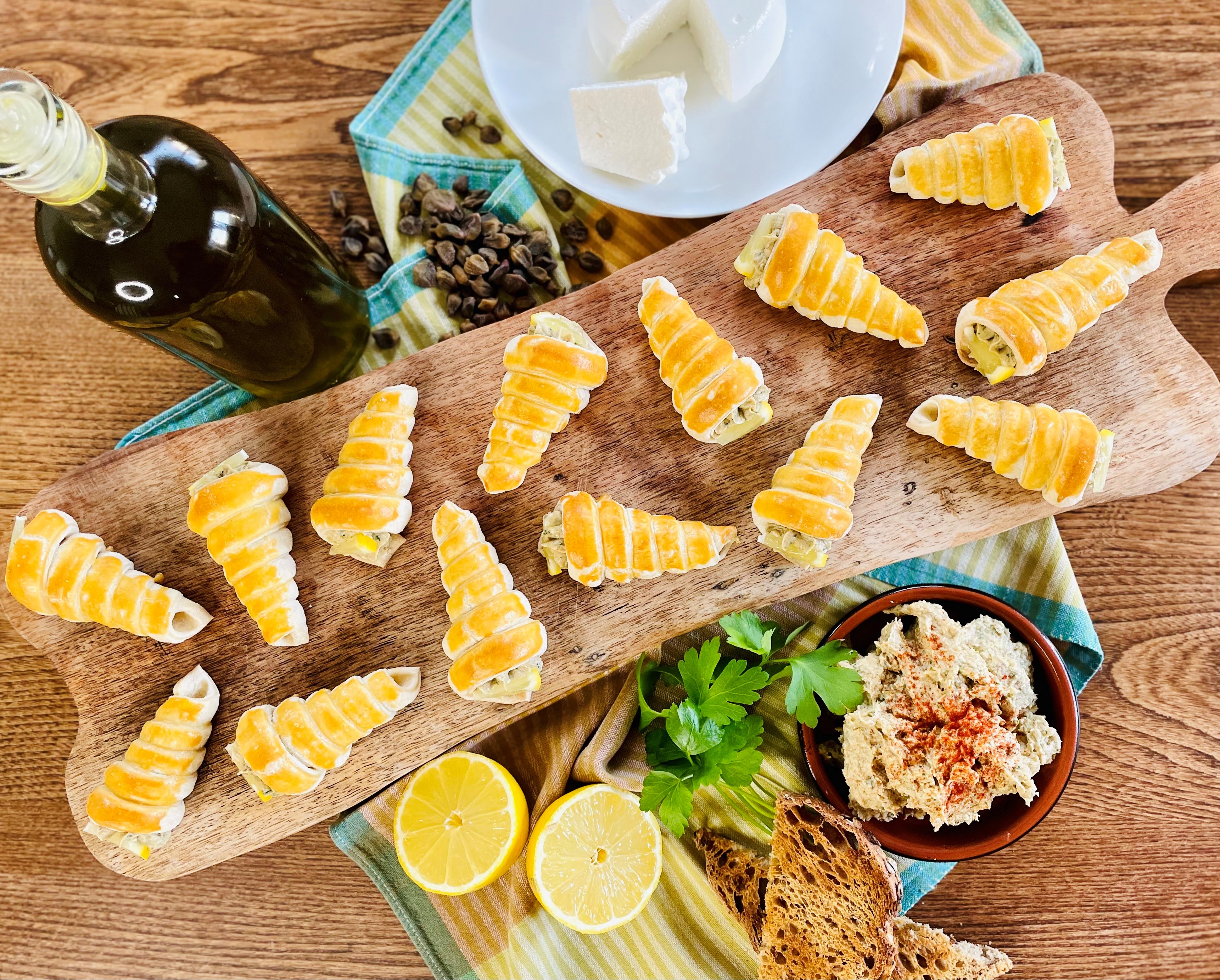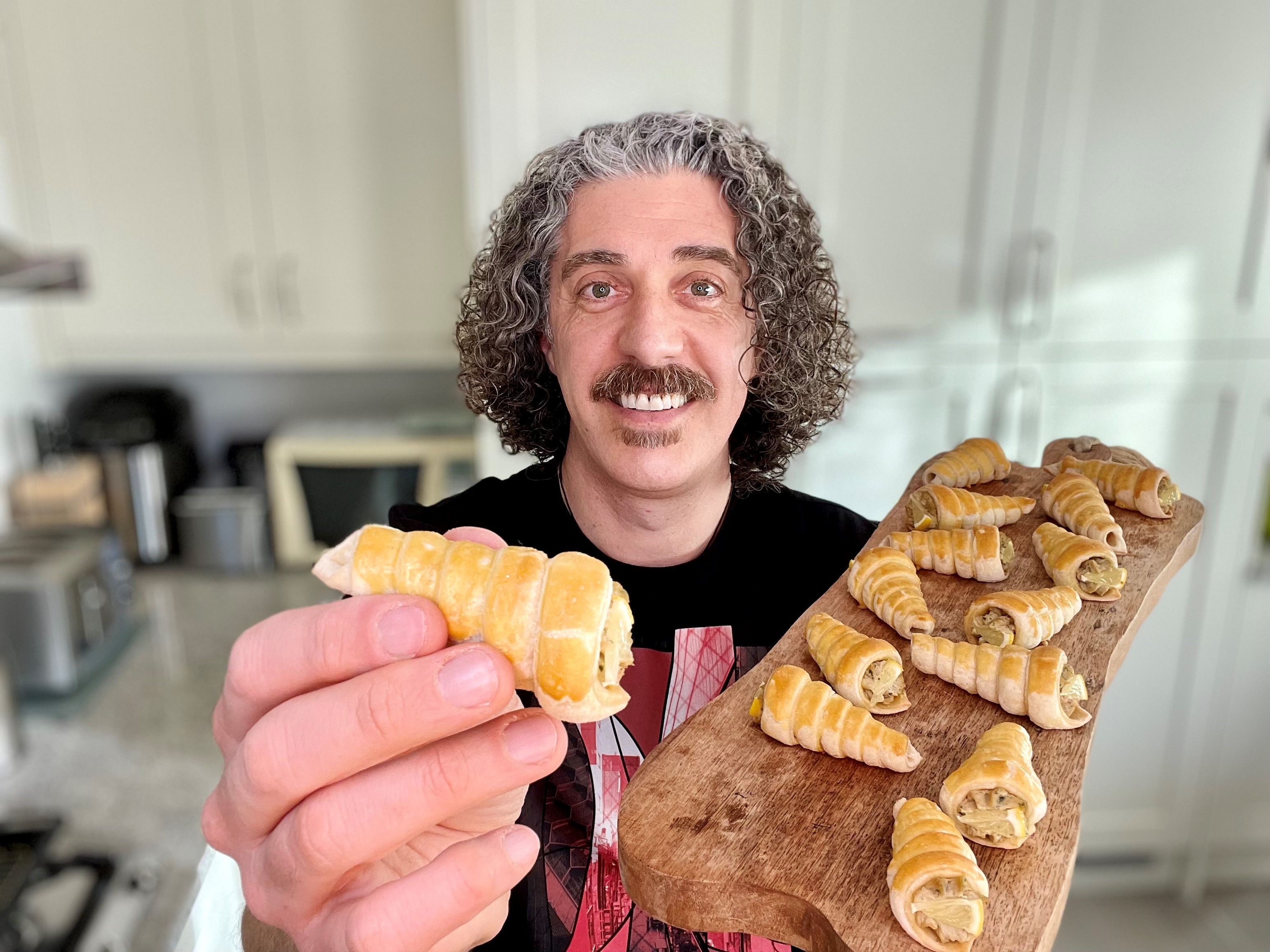GBBO winner Giuseppe’s Puff pastry horns with smoked mackerel creamy pâté

Fish pâté is a staple of any summery meal outdoor; in this version, I am using ricotta and olive oil instead of the conventional cream cheese to give it a softer, pipeable texture and a smoother flavour, so you can enjoy a more generous filling of the flaky puff pastry horns.
This recipe is very versatile: if you don’t have cone-shaped moulds, you can simply bake the puff pastry in a greased muffin tray and make cups of pâté rather than horns. Or you can avoid the pastry altogether and go for an even simpler version spreading the pâté over good sourdough toasted slices.
Serves: 12
Plus: bakes over cone-shaped moulds
Ingredients
For the puff pastry horns
- 200g all-butter puff pastry (chilled or frozen)
- Plain flour for dusting
- 1 egg yolk
For the smoked mackerel creamy pâté
- 130g smoked mackerel fillets (1 medium sized fillet)
- 1 tbsp capers
- Bunch of fresh parsley (approximately 15g)
- 1 large organic lemon
- 130g ricotta
- 1 tbsp extra virgin olive oil
- 1 tbsp paprika
- 1/8 tsp ground pepper
Method
Make the puff pastry horns
- If the puff pastry is frozen, take it out of the freezer the day before baking and thaw it overnight in the fridge.
- Leave the puff pastry at room temperature for one hour before unpacking it. Avoid unpacking it when still cold or the condensation will make it very sticky.
- Line a large baking sheet with baking paper or with a silicone mat.
- Preheat the oven to 190°C static or 175°C fan.
- Generously flour the working surface and roll the puff pastry to shape it into a square, 25cm side and 3mm thick. Try to keep the square shape as regular as possible while rolling the pastry.
- Using a rigid ruler and a pizza cutter, divide the square into 12 strips of pastry, each 2cm wide. If you use a knife instead, cut the pastry with a guillotine motion, avoid dragging the blade as the pastry is very soft and deforms easily.
- Wrap each strip of pastry around the cone mould, starting from the tip and overlapping the spires by half a centimetre. You might need to gently seal the spires over each other to ensure the shape stays together.
- Arrange the horns and moulds on the baking sheet at least 2cm apart.
- Gently brush the top of each horn with the beaten egg yolk using a pastry brush.
- Bake in the middle shelf of the oven for 18 to 20 minutes or until the top of the pastry is a deep amber colour.
- Let the pastry horns cool down completely before extracting the moulds.
While the pastry is baking, make the pâté
- Skin the mackerel fillet, break it in chunks and add it to the bowl of a food processor.
- Rinse the capers under running water, squeeze the excess water and add them to the food processor.
- Finely chop the parsley leaves and stems and add them to the food processor.
- Wash and pat dry the lemon, cut it in half. Cut a 3mm round slice from one of the two lemon halves and set it aside for later.
- Add the zest of half lemon to the food processor.
- Squeeze the lemon and add one tablespoon of juice to the food processor.
- Finally, add ricotta, olive oil, paprika, and pepper to the food processor and blitz until smooth and creamy; it should take approximately 1 minute at high speed. Scrape the sides of the bowl with a spatula midway through the process.
Assemble and decorate
- Transfer the pâté to a piping bag with a medium sized nozzle, about 8-10mm diameter, plain or star. If you are using a disposable piping bag, you may avoid using a nozzle altogether and just cut the tip of the bag to make an 8mm opening.
- Pipe the pâté into the puff pastry horns until they are generously filled.
- Cut the slice of lemon set aside earlier into 12 thin wedges and decorate each horn with one wedge.

Recipe courtesy of Giuseppe, @giuseppecooks
